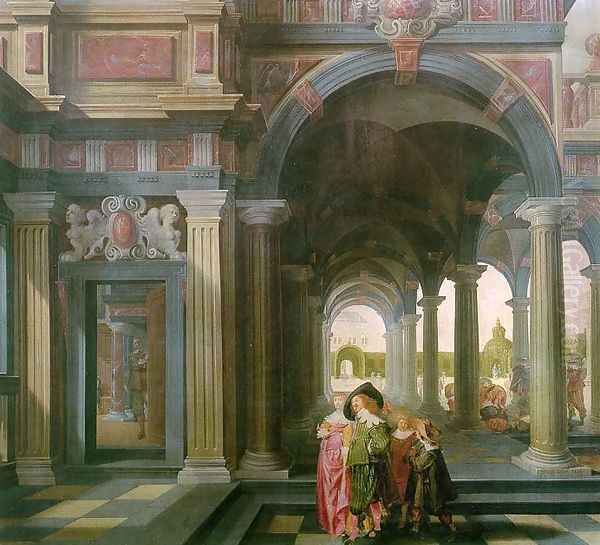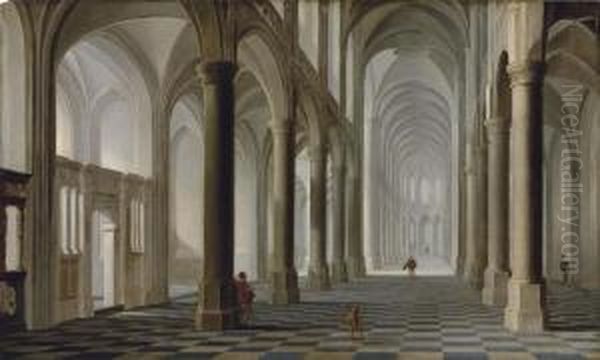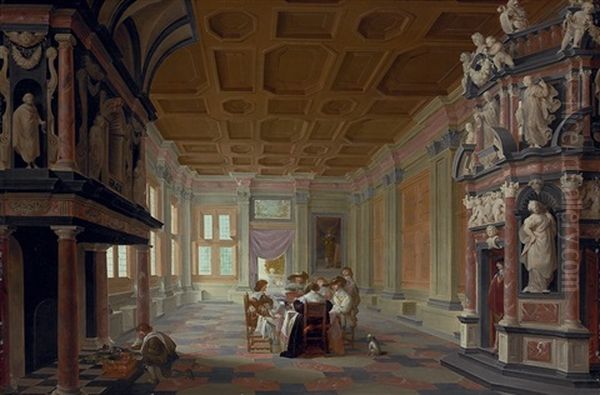Dirck van Delen stands as a significant figure in the rich tapestry of Dutch Golden Age painting. Active during the 17th century, a period of extraordinary artistic flourishing in the Netherlands, Van Delen carved a distinct niche for himself as a master painter of architecture. His works, often depicting imagined or idealized palaces, church interiors, and stately courtyards, are celebrated for their meticulous detail, sophisticated understanding of perspective, and dramatic use of light and shadow. While perhaps not as universally recognized today as contemporaries like Rembrandt or Vermeer, Van Delen was highly respected in his time, both as an artist and a civic leader. This exploration delves into the life, artistic style, key works, and professional relationships of this accomplished Dutch master.
Early Life and Artistic Formation
Dirck Christiaensz. van Delen was born around 1604 or 1605 in Heusden, a town located near 's-Hertogenbosch in the Dutch Republic. Details about his earliest years and initial training remain somewhat scarce, a common challenge when researching artists from this period. However, art historians speculate about his formative influences. It is considered possible that he received instruction from Hendrick Aertsz., another painter known for his architectural fantasies. Aertsz.'s work, along with the broader tradition of architectural painting established by pioneers like Hans Vredeman de Vries and Hendrick van Steenwijck the Elder and Younger, likely provided a foundation for Van Delen's burgeoning interest in the genre.
These early influences would have exposed him to the principles of linear perspective, which were becoming increasingly sophisticated and popular among Dutch artists. The meticulous rendering of architectural space, whether real or imagined, required a strong grasp of geometry and spatial illusion. Van Delen's later works demonstrate a profound mastery of these techniques, suggesting a rigorous early training, possibly supplemented by the study of architectural treatises and prints that circulated widely at the time. His initial artistic inclinations seem to have leaned towards these more fantastical architectural compositions, a common starting point for painters in this specialized field.
Relocation and Establishment in Zeeland

A pivotal moment in Van Delen's life occurred when he moved south to the province of Zeeland. He initially settled near the prosperous trading city of Middelburg before establishing himself more permanently in the smaller nearby town of Arnemuiden. This relocation proved significant for both his personal and professional life. In 1625, he married Maria van der Gracht in Middelburg. Interestingly, Maria was reportedly almost twenty years his senior. This marriage coincided with him becoming a citizen of Middelburg in the same year, formally integrating him into the local community.
Shortly after his marriage, in 1626, the couple settled definitively in Arnemuiden, which would remain Van Delen's home base for the rest of his life. Arnemuiden, though smaller than Middelburg, was a town with its own maritime and civic importance within Zeeland. It was here that Van Delen truly established his career and reputation. His early dated works begin to appear around this time, including the significant Palace Interior with the Parable of the Rich Man and Lazarus from 1626. This painting already showcases his developing skill in rendering complex architectural settings populated with figures, blending biblical narrative with opulent, imagined interiors.
Civic Engagement and Guild Membership
Beyond his artistic pursuits, Dirck van Delen became deeply involved in the civic life of Arnemuiden. This level of community engagement was not unusual for successful artists and craftsmen in the Dutch Republic, where civic pride and participation were highly valued. In 1628, just a few years after settling in the town, he was appointed as a tax collector ('ontvanger der gemeene middelen'), a position of considerable responsibility requiring trustworthiness and administrative skill.
His involvement in local governance did not end there. Records indicate that Van Delen served multiple terms as a burgomaster (mayor) of Arnemuiden, demonstrating the high esteem in which his fellow citizens held him. Balancing these demanding civic duties with a productive artistic career speaks volumes about his energy and standing. Furthermore, his connection to the broader artistic community is evidenced by his membership in the prestigious Guild of Saint Luke in nearby Middelburg, the main center for artists and artisans in the region. He is documented as a member of the guild between 1639 and 1665, indicating his sustained professional activity and recognition among his peers.
Artistic Style: Perspective, Detail, and Light

Dirck van Delen's artistic style is firmly rooted in the Dutch Baroque tradition, specifically within the specialized genre of architectural painting. His work is characterized by several key features, most notably his exceptional command of linear perspective. He employed perspective not just as a technical tool but as a primary compositional element, creating convincing illusions of deep, receding spaces that draw the viewer into the scene. His interiors, whether churches or palaces, often feature dramatic vanishing points and meticulously rendered tiled floors that emphasize the spatial depth.
Complementing his mastery of perspective was an extraordinary attention to detail. Van Delen delighted in depicting the textures and ornamentation of architectural elements – polished marble columns, intricate carvings, coffered ceilings, decorative friezes, and elaborate stonework. This precision lends a sense of realism and opulence to his scenes, even when the architecture itself is largely fantastical. He often combined elements from different architectural styles, blending Renaissance and Baroque motifs to create grand, eclectic settings.
The use of light and shadow, or chiaroscuro, is another defining characteristic of Van Delen's style. He skillfully manipulated light to create atmosphere, highlight specific architectural features, or add dramatic emphasis to the figures within his scenes. Sunlight often streams through high windows or archways, illuminating parts of the vast interiors while leaving other areas in deep shadow. This interplay of light enhances the sense of volume and three-dimensionality, contributing significantly to the overall impact of his paintings. His palette generally consisted of rich, though sometimes subdued, colors that further enhanced the sense of realism and material richness.
Themes and Subject Matter
While primarily known as an architectural painter, Van Delen explored several related themes within this specialization. His oeuvre includes depictions of imaginary palace interiors and courtyards, church interiors (both Gothic and Renaissance/Baroque styles), and occasionally, scenes incorporating specific historical or biblical narratives.
The palace scenes often depict opulent, expansive halls and courtyards populated by elegantly dressed figures engaged in leisurely activities or conversation. These works, such as the Palace Courtyard with Figures (1635), showcase Van Delen's ability to create idealized visions of wealth and grandeur, often drawing inspiration from Italian Renaissance architecture but reinterpreting it with a Northern European sensibility. These paintings appealed to the tastes of affluent Dutch burghers who appreciated displays of order, perspective, and imagined luxury.

His church interiors represent another significant portion of his output. He painted both existing and imagined churches, sometimes blending elements of different structures. Works like Interior of a Gothic Church (1641) demonstrate his ability to capture the soaring verticality and complex structure of Gothic architecture, often enhanced by dramatic lighting effects. He also depicted more contemporary Baroque-style church interiors. Occasionally, these church settings served as backdrops for biblical scenes, such as Christ Healing the Lame Man (c. 1636), or historical events.
A particularly notable and unusual work is Iconoclasm in a Church (1630). This painting depicts the 'Beeldenstorm' (Iconoclastic Fury) of 1566, when Protestant reformers destroyed religious images in Catholic churches across the Low Countries. It is reportedly Van Delen's only known depiction of this specific historical event, showcasing his ability to integrate narrative action within a detailed architectural setting, capturing the chaos and destruction within the sacred space.
Collaboration with Figure Painters
Like many architectural specialists of the Dutch Golden Age, Dirck van Delen frequently collaborated with other artists who specialized in figure painting. Creating convincing architectural settings required a specific skill set focused on perspective and structure, while populating these scenes with lively, well-painted figures ('staffage') often demanded different expertise. Collaboration was therefore a practical and common practice, allowing each artist to contribute their strengths.
Van Delen is known to have worked with several prominent figure painters. His most frequent collaborator appears to have been Anthonie Palamedesz., a Delft painter known for his portraits and genre scenes, particularly 'merry companies' and guardroom interiors. Their joint works, such as the aforementioned Interior of a Gothic Church (1641), successfully integrate Palamedesz.'s figures into Van Delen's architectural frameworks.
He also collaborated with Dirck Hals, the younger brother of the famous portraitist Frans Hals. Dirck Hals specialized in genre scenes, particularly elegant companies enjoying music or festivities. Records suggest collaborations where Van Delen provided the architectural setting and Hals added the figures, likely before 1634. Other documented collaborators include Pieter Codde and Jan Olis, both known for their genre scenes and guardroom pictures, and the Antwerp painter Theodoor Boeyermans, with whom he worked on at least one large allegorical painting. These collaborations highlight Van Delen's integration within the broader artistic network of the Dutch Republic and Flanders.
Context: Architectural Painting in the Dutch Golden Age
Dirck van Delen worked within a flourishing tradition of architectural painting in the 17th-century Netherlands. This genre gained significant popularity, appealing to a clientele fascinated by perspective, order, civic pride, and the representation of impressive interior spaces, both real and imagined. The foundations were laid by earlier artists like Hans Vredeman de Vries, whose influential pattern books spread designs for fantastical Renaissance architecture, and the Hendrick van Steenwijck dynasty (Elder and Younger), who pioneered detailed church interior views.
During Van Delen's active period, the genre diversified. Artists like Pieter Saenredam became renowned for their highly accurate, almost topographical depictions of existing Dutch church interiors, characterized by bright light and meticulous attention to architectural detail. Emanuel de Witte and Gerard Houckgeest also specialized in church interiors, often focusing more on atmospheric effects, the play of light, and the human element within the sacred space. Bartholomeus van Bassen, active primarily in The Hague, was another key contemporary known for his elaborate, often imaginary, palace and church interiors, representing a direct parallel and likely competitor to Van Delen.
Van Delen's work occupies a space somewhat between the pure fantasy of Vredeman de Vries and the precise realism of Saenredam. While his perspective was rigorous and his details often sharp, his architectural settings were frequently idealized composites or entirely imagined creations, imbued with a sense of grandeur and sometimes theatricality that distinguished his style. He faced competition from these and other artists, including painters like Willem van Mieris and potentially even high-profile figures like Bartholomeus van der Helst (though primarily a portraitist, the art market was interconnected), vying for patronage among the wealthy merchant class and civic institutions.
Later Life and Personal Circumstances
Dirck van Delen's personal life saw further changes in his later years. His first wife, Maria van der Gracht, passed away sometime before 1650. In October 1650, he married his second wife, Constance van Baelen (also recorded as Van Bael), who was the widow of a Middelburg surgeon. Unfortunately, this marriage was also relatively short-lived, as Constance passed away in September 1651.
Undeterred, Van Delen married for a third time in January 1658. His third wife was Catharina de Hane (or De Haene), the widow of Johan van Baelen, possibly related to his second wife's family. Despite these three marriages, historical records indicate that Dirck van Delen died without leaving any children. These repeated marriages and subsequent widowhoods paint a picture of a personal life marked by loss, yet also by a continued desire for companionship and family structure, even as he maintained his active career as an artist and respected citizen of Arnemuiden. His ability to continue producing high-quality artwork throughout these personal upheavals underscores his dedication to his craft.
Death and Legacy
Dirck van Delen passed away in Arnemuiden in May 1671. He was buried there on May 16th, 1671, reportedly at the age of 66. His death was marked by his community, and his tombstone in the Arnemuiden church served as a testament to his long-standing presence and status within the town he had called home for nearly half a century.
His legacy endures primarily through his impressive body of work. Dirck van Delen is recognized as one of the leading Dutch architectural painters of the 17th century. His paintings are admired for their technical brilliance, particularly the masterful handling of perspective and the intricate rendering of architectural detail. He successfully blended elements of realism and fantasy, creating compelling visions of space and structure that captivated his contemporaries and continue to engage viewers today.
His works are held in numerous major museum collections around the world, including the Rijksmuseum in Amsterdam, the Louvre in Paris, the National Gallery in London, and the Metropolitan Museum of Art in New York (which holds his Palace Courtyard with Figures). Through these preserved works, Dirck van Delen's contribution to the Dutch Golden Age remains accessible, offering a fascinating window into the era's preoccupation with space, order, and the representation of magnificent architecture, both real and imagined. He remains a key figure for understanding the development and diversity of architectural painting during this vibrant period of European art history.